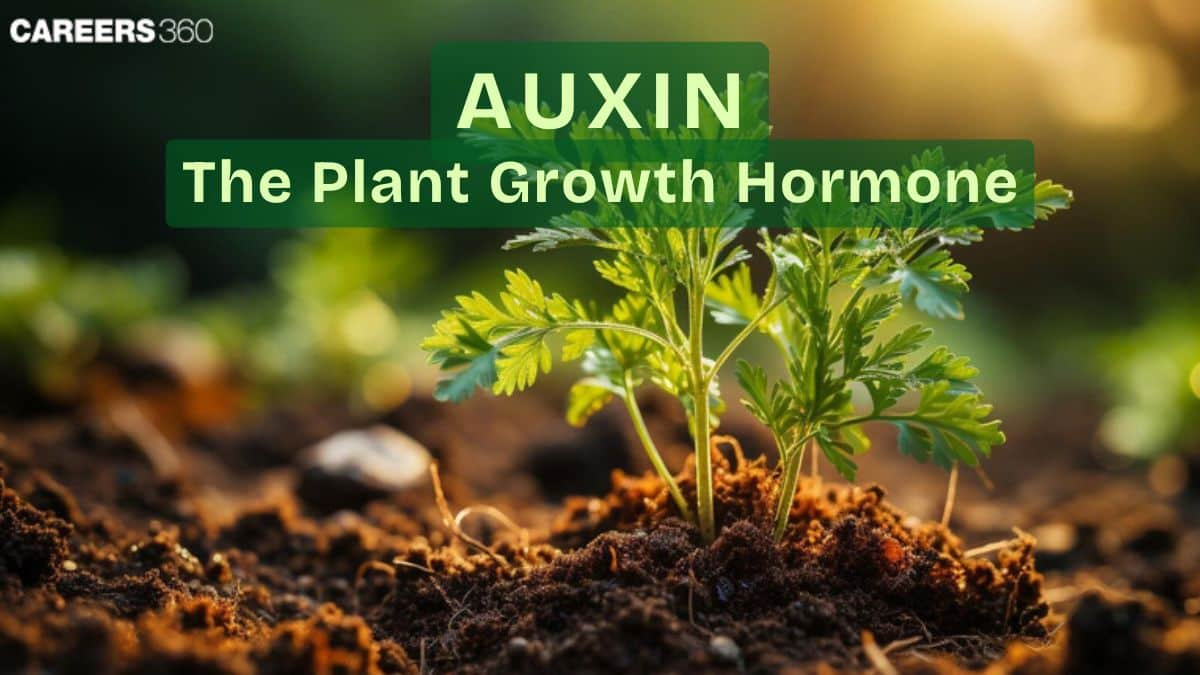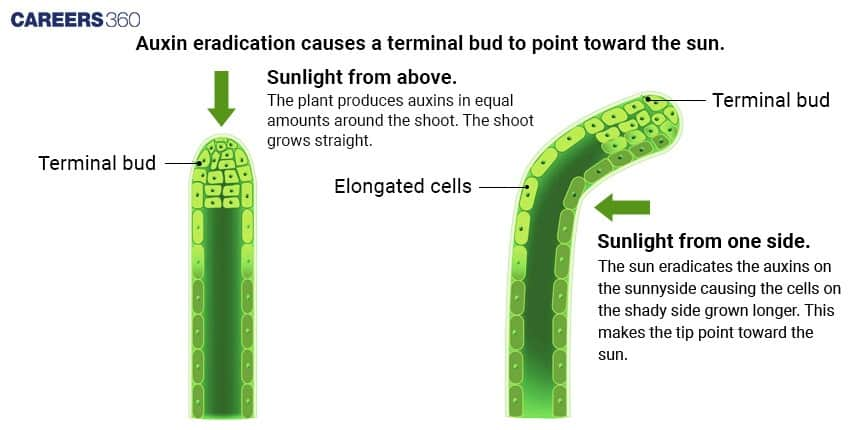Auxins: The Plant Growth Hormone: Definition, Functions, & Uses
Auxins are primary plant hormones that control cell elongation, apical dominance, root initiation, and tropisms. They are produced mainly in shoot apices and transported downward in a polar manner to regulate plant architecture. Auxins are essential NEET concepts, forming the foundation of plant growth regulation and tissue culture.
This Story also Contains
- What Is Auxin?
- Types of Auxins
- Mechanism Of Action Of Auxin
- Functions of Auxin
- Auxin vs Cytokinin (Comparison Table)
- Auxin NEET MCQs (With Answers & Explanations)
- Recommended Video on Auxins: The Plant Growth Hormone

What Is Auxin?
Auxins are a class of naturally occurring and artificially synthesised hormones of plants. They play a significant role in the regulation of growth in plants. Auxins were initially extracted from human urine. Auxin means to "enlarge" or "increase". They induce cell division, differentiation and elongation.
Charles Darwin discovered the phototropism movement of bending towards light in the coleoptile of canary grass. He demonstrated that there was some influencer at the tip of the coleoptile, responsible for the bending towards the light. Subsequently, Frits Went isolated and named the substance "Auxin", responsible for phototropic movement in oat coleoptiles. Kenneth Thimann purified and elucidated the structure of primary auxins, e.g. IAA (Indoleacetic acid).
Types of Auxins
There are two main types of auxins:
Naturally Occurring: Indole-3-acetic acid, Indole butyric acid
Artificially Synthesized: 2,4-dichloro phenoxy acetic acid, Naphthalene acetic acid
Mechanism Of Action Of Auxin
The mechanism of action of auxin is:
Auxin is mostly produced in the apical meristem of shoots, young leaves and seeds
The movement of auxin is unidirectional or polar, it moves downwards from its site of production
Polar transport results in an auxin concentration gradient, which stimulates specific responses
Transport proteins specific for auxin in the plasma membrane regulate the transport of auxin out of the cell
Plant hormones operate via signal transduction and many induce more than one cellular responses
Auxin acts by binding to enzyme-linked receptors, which enhances the catalysis of a reaction
When auxin binds to a receptor, it binds to repressor protein for certain genes, auxin response genes, leading to degradation of the repressor protein and thus the transcription of auxin response genes leading to cellular growth and development

Functions of Auxin
The functions of auxin includes:
Cell Elongation
It promotes elongation in shoots and coleoptiles. The plasticity of the cell wall is increased by acidification
Cell Division and Differentiation
Auxin promotes healing. It helps in cell differentiation and regeneration of vascular tissues phloem, xylem
Callus Formation
Auxin along with cytokinin induces callus formation in explant and stimulates morphogenesis
Secondary Growth
Auxin promotes secondary growth and induces cell division in the vascular cambium
Root Initiation in Cuttings
For asexual propagation, NAA is used to initiate root formation in the stem cuttings
Apical Dominance
It refers to the inhibition of the growth of axillary buds by the growth of apical meristem. Removal of the shoot tip induces the growth of lateral buds. Hence, this is employed to develop branching, e.g. hedge-making and tea plantations.
Parthenocarpy
Application of auxin to some flowers leads to parthenocarpy, i.e. ovary enlarges and develops into seedless fruit unfertilized. Seedless tomatoes are widely produced by this method.
Fruit development
Auxin is produced by seeds and it stimulates fruit development with gibberellins and delays senescence.
Herbicidal Action
Synthetic auxins, e.g. 2,4-D and 2,4,5-T are used extensively to kill weeds. It does not affect grasses, i.e. monocotyledons.
Tropism
The auxin induces phototropism, gravitropism and thigmotropism, i.e. movement in response to light, gravity and touch respectively. Phototropic movement can be explained by the cell elongation due to auxins. Auxin concentration increases towards the dark side due to auxin migration. That means more cell elongation occurs at the shaded side compared to the side which receives light.
Auxin vs Cytokinin (Comparison Table)
The difference between auxin and cytokinin is given in the table below:
Feature | Auxin | Cytokinin |
Primary function | Elongation | Cell division |
Root/Shoot | Promotes root formation | Promotes shoot formation |
Dominance | Apical dominance | Lateral bid growth |
Tissue culture | Root induction | Shoot induction |
Examples | IAA, NAA | Zeatin, Kinetin |
Auxin NEET MCQs (With Answers & Explanations)
Important topics for NEET are:
Functions of Auxin
Mechanism of action of Auxin
Practice Questions for NEET
Q1. Who isolated the first naturally occurring auxin in human urine?
Boysen-Jensen
Charles Darwin and his son Francis
Went
Kogl and Haagel-Smit
Correct answer: 4) Kogl and Haagel-Smit
Explanation:
The first natural product auxin was to be identified as an auxin-a, discovered in human urine by the Dutch biochemists Kogl and Haagel-Smit in 1934. This became a significant advancement in plant physiology since auxins were a critical control factor in the growth of plants and their development. Later, it was identified as IAA or indole-3-acetic acid, and it is currently known to be the most abundant natural auxin of the plant.
Hence, the correct answer is option 4) Kogl and Haagel-Smit.
Q2. Plants are attracted to light through the hormonal action of :
Gibberelic acid
Auxin
Chlorophyll
Thiamine
Correct answer: 2) Auxin
Explanation:
The elongation of the plant cells in a stem is the primary function of the Auxin. They are responsible for phototropism which means the growth of a plant towards the light. The unequal distribution of the auxin is responsible for the response of plant shoots and roots to gravity, light, and moisture. Auxin stimulates the growth of cells on the shady side of the plant which causes bending of the plant to the other side.
Hence, the correct answer is option 2) Auxin.
Q3. Which form of auxins is hormonally inactive and meant for storage?
Free auxins
Synthetic auxins
Bound auxins
Anti-auxins
Correct answer: 3) Bound auxins
Explanation:
Bound auxins are hormonally inactive and are meant for storage. They cannot be extracted except with the help of organic solvents.
There are two types of auxins: bound auxins (inactive) and free auxins (active). Plant cells store bound auxins by binding to proteins, carbohydrates, or amino acids. When necessary for plant growth this stored form permits controlled release and inhibits excessive auxin action. Bound auxins can change into their active state when necessary to control functions including root growth and cell elongation.
Hence, the correct answer is option 3) Bound auxins.
Also Read:
Recommended Video on Auxins: The Plant Growth Hormone
Frequently Asked Questions (FAQs)
Man-made or synthesized auxins like 2,4-D and 2,4,5-T act in killing many weed dicots, without much effect on plants like grasses.
What are the naturally occurring and artificially synthesized auxins? The naturally occurring auxins are Indole-3-acetic acid and Indole butyric acid. The artificially synthesized auxins include 2,4-dichloro phenoxy acetic acid and Naphthalene acetic acid.
Auxin increases the plasticity of the cell wall, which enables the wall to expand under the influence of turgor pressure thus promoting cell elongation.
Apical meristem-produced auxin inhibits axillary bud growth; a phenomenon termed apical dominance. Axillary buds are released from apical inhibition by removing the shoot tip.
Parthenocarpy is induced in some flowers by applying auxin to artificially stimulate the ovary to develop into a fruit without the need for fertilization. This technique is applied in developing seedless tomatoes.